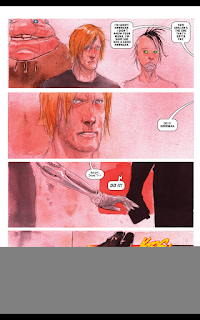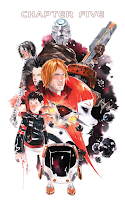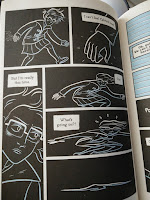If I had to describe Ghostopolis in a few words I would say "Fun and adventure cinematic story." This is a book for young teens and adults young at heart. Ghosthopolis tells the adventures of Garth Hale after he is accidentally sent to the world of the afterlife. Frank Gallows (the agent who sent Garth there) and his ex-girlfriend ghost Claire Voyant, both former members of the Supernatural Immigration Task Force, decide to go to his rescue and get him back to earth. Garth's strong life force attracts the attention of Ghostopolis's ruler Vaugner, who tries to capture him to get Garth's energy and use it for evil purposes. Garth happens to find her grandpa Cecil right after landing, although in a form of a child of his age who keeps growing and becoming an adult during the story.
This is an old-style comic book, one of those I grew up reading when I was a kid: entertaining, imaginative, good graphics, full colour, battles, adventure, the heroes and the badies, fun, lots of fun!, monsters, skulls, skeletons, castles, mummies. One of those books you cannot put down until you finish reading it in a seating.The book targets children, so the narrative has the common clichés of the genre, and of course is predictable, but that doesn't rest interest or fun to the reading.
The adventures being mostly in the afterlife, one would expect macabre and very dark images, but the contrary is true. All the creatures in the afterworld are likeable, funny, naughty and not scary at all. There is a bit of Christian symbolism in the book but it is very subtle, not straightforward, and not preachy at all. The creator is called Joe the builder, a Tuskegee airman, an Afro-American pilot of the WW2.
One of the things I love the most about the book is how cinematic it feels, and how funny is. The character of Frank Gallows is really a cracker, cheeky and likeable. Some of the names are also very funny, like Claire Voyant, or Boogie Boogie Avenue. Vaughner, the bad-man, looks very much like a punk-rock Bylly Idol, although the mouth is very much Marilyn Mason, and he is wearing skinny jeans! Some of the dialogues are also light-hearted and full of pun:
"Assemble my fastest team of night mares, a company of royal skeleton guards, and a carriage for thet wo lovebirds" [the skeleton king says when ordering to prepare his horses] (p. 183)
"Well show them that you don't have to have organs to have guts!" [the skeleton says] (p. 194)
The novel immediately reminds one of
Ghostbusters, and of some of Tim Burton's early movie, in which the extraordinary and the ordinary live in dysfunctional harmony. However, to be fair, we cannot reduce the plot or the novel to a Burton-alike story because darkness seems always more natural than the normal world or normal people in Burton's Universe, and that is not the case here. Unlike
Ghostbusters, the ghosts in this novel aren't on earth to scare anybody, they are there to enjoy the peaceful surroundings as the afterlife is a bit messy. In that regard,
Man in black seems more in tune with this story, especially having a group of police officers devoted to capture intruder ghosts and bring them back to their own world.
I don't think the book has anything really that would bother parents to give their children, even if they are agnostics, lapse Christians, Buddhists or Hindus.
PLOT HOLES
> If Garth is dying, why is his energy in the afterworld so humongous? After all he has just a few weeks of life left. I think the fact that he was so sick was a reason why the accident happened; otherwise, the plasma device would have not been taken him. Just saying!
> The appearance of Garth's son is senseless and breaks the rules of believality. One understands that the afterlife has not time or space. Great, but for the sake of the story, please show old Cecil.
THE GRAPHIC ART
Dough TenNapel is not only the author of the story, is also the main illustrator, drawer and penciler/inker. He has a great talent and can do anything: beautiful rural escapes, cityscapes or action-packed crazy scenes. The arrangement of the vignettes is very dynamic and never boring, and every few pages there is a B&W silhouetted vignette inserted between the others, a kind of wink to the reader. I think that TenNapel shines when he creates simpler images, less busy visually, which are among my favourites. I loved the graphic depiction and development of
some of the characters: Claire, Frank, Vaughner, the skeleton king, and all the mumies. I didn't
like the depiction of Garth, his mother, and I hesitate about Joe as much .
I found the subdued and washed out colouring very good, similar to that in old vintage comics. Not my favourite sort of colouring, but splendid nevertheless.There is a large group of colourists who have to be praised: The lead colourists are Katherine Gardner and Tom Rhodes, helped by assistants Matt Laskodi, Aaaron Crayne, Wes Scog, Rick Randolph, Kenny Hitt,
Ethan Nicolle, Eric Barnscume, Dirk Erick Schulz, Sean McGowan and David Kowalyk.
The author of the lettering is not mentioned in the credits, but the lettering is one of the best things in this book. I absolutely loved the lettering fonts, sizing and colouring, even the accurate onomatopoeyic wording of it. The wording felt like real sounds in my head, not like other times when I read the ambience noises in a comic and I don't hear anything in my head. The lettering perfectly suits the book overall look and style, and it is in harmony with it.
LET'S COMMON SENSE PREVAIL
This review is about the graphic novel not about the author's ideology of way of living or thinking. I'm not here to befriend this guy either. Too bad that he seems to have a name for being a very-conservative Christian and anti-gay rights person. However, this graphic novel doesn't deal with any of those things, it is a children book. Although there is a bit of Christian symbolism (the book happens to be a story that happens in the afterlife, hello hello) the symbolism is very subtle. I would not be offended if an Hindu had created the same story and used the Hindu gods and goddesses in the book instead of Joe, so why would I be offended here? I don't think it will offend anybody who is not easily
offended. As long as the author doesn't preach me anything, I am OK with that. This book has no preaching in it, so it is all fine with me. Kids won't be discussing this stuff. They will be commenting on the adventures they have just read. I got a comic book and I am reviewing *it*. Then, if the author makes an anti-gay comic or a white supremacist one, I would show my fangs.
MIND
More for mid-grade children than for proper teens, I think. I would say about 8-13y.o.a. Older children would be already reading adults stuff or complex books to feed their hunger for adulthood.
NOTE
A
movie based on the novel is in development at the time of this review. TenNapel gave an interview about comic creation where he gives some details about the film. The interview is on
YouTubbe (1h +).
























































